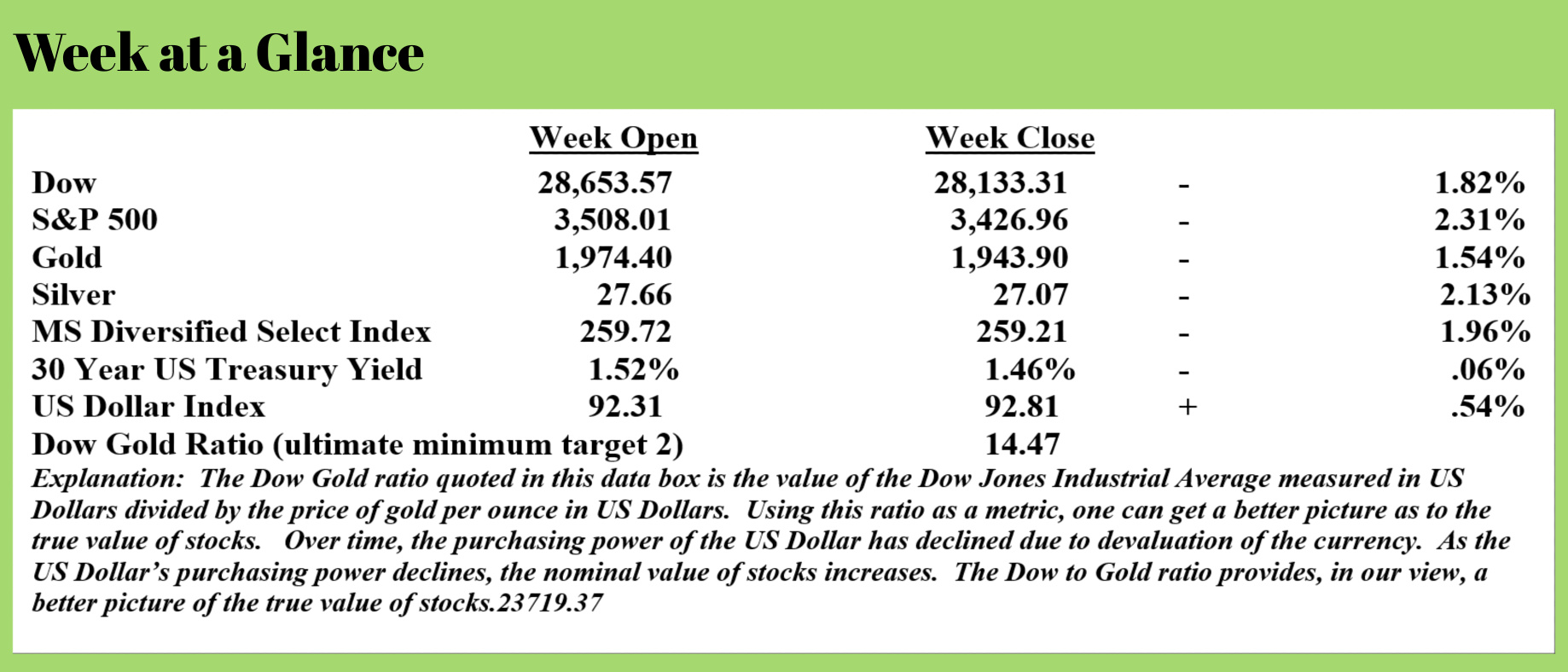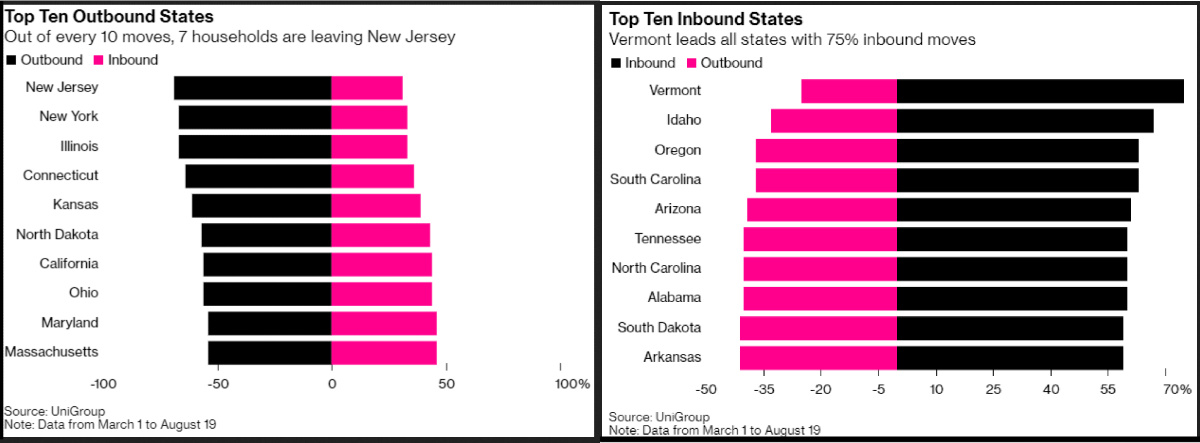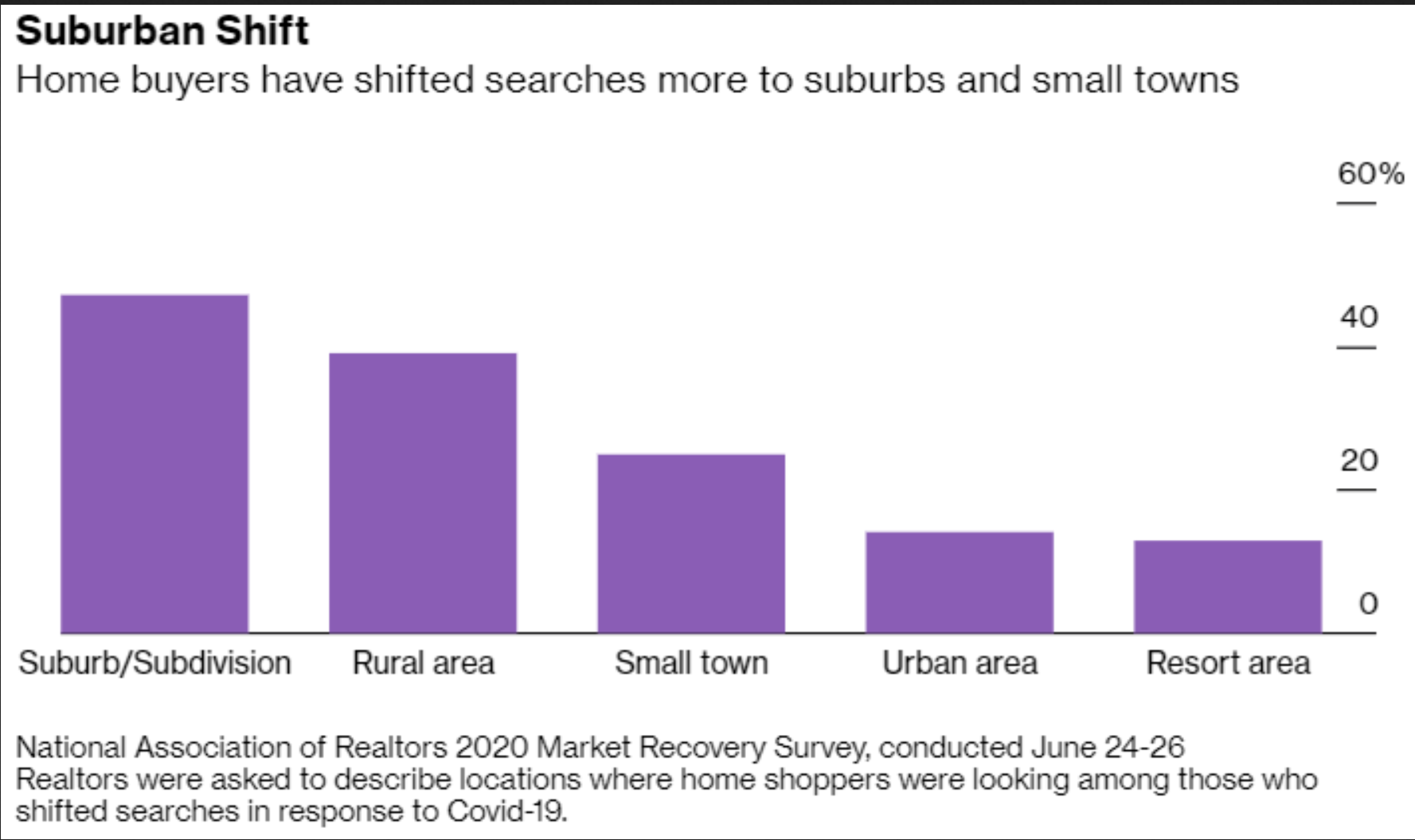
 Weekly Market Update by Retirement Lifestyle Advocates
Weekly Market Update by Retirement Lifestyle Advocates

The exodus from major cities continues.
To follow up on one of the trends that we have discussed in detail over the past couple of months, the migration from the city to the country is intensifying.
“The New York Times” published two separate stories on Monday highlighting how moving companies are actually turning away customers due to excessive demand for their services.
Those with the means to exit the city are doing so as rioting persists and crime rates rise.
This from “Zero Hedge” (Source: https://www.zerohedge.com/markets/demand-insane-nyc-movers-turn-people-away-suburban-rural-housing-snagged-big-city-covid) (emphasis added):
There's fresh data showing that during the pandemic Americans are fast getting the hell out of the more expensive "real estate meccas" of New York and New Jersey.
First, New York City moving (companies) are reporting a rush of customers so high it feels like "move out day on a college campus".
According to FlatRate Moving, the number of moves it has done has increased more than 46 percent between March 15 and August 15, compared with the same period last year. The number of those moving outside of New York City is up 50 percent — including a nearly 232 percent increase to Dutchess County and 116 percent increase to Ulster County in the Hudson Valley.
“The first day we could move, we left,” a dentist was cited as saying of the moment movers were declared an "essential service" by Gov. Cuomo late March. Her family moved to Pennsylvania where they had relatives.
And second, the Times details the unprecedented boom in the suburban real estate as an increasingly online workforce is fed up with closures in the city, losing its appeal and vibrancy.
July alone witnessed a whopping 44% increase in home sales among suburban counties near NYC compared to the same month last year, as the report details:
Over three days in late July, a three-bedroom house in East Orange, N.J., was listed for sale for $285,000, had 97 showings, received 24 offers, and went under contract for 21 percent over that price.
On Long Island, six people made offers on a $499,000 house in Valley Stream without seeing it in person after it was shown on a Facebook Live video. In the Hudson Valley, a nearly three-acre property with a pool listed for $985,000 received four all-cash bids within a day of having 14 showings.
Since the pandemic began, the suburbs around New York City, from New Jersey to Westchester County to Connecticut to Long Island, have been experiencing enormous demand for homes of all prices, a surge that is unlike any in recent memory, according to officials, real estate agents and residents.
They're not just fleeing for the suburbs or upstate, but also to the significantly cheaper and lower cost of living areas of the country like Texas, Florida, South Carolina, and Oregon, or to rural areas.
This level of migration has not occurred since the mid 20th century.
“Bloomberg” published two charts illustrating the winning states and losing states in this robust migration.

The first chart illustrates the top ten outbound states. New Jersey is at the top of this list with 70% of the moves involving New Jersey being outbound moves. New York, Illinois, and Connecticut are next on the list.
This chart leads to the next chart which helps us understand what states people are moving to.
The State of Vermont is a popular choice with 75% of the moves involving that state being inbound moves. Idaho, Oregon, and South Carolina are the next most popular destinations on the list.
The National Association of Realtors conducted a survey among its members in June asking them in what areas prospective home buyers were searching.
Leading the way was suburban areas, followed by rural areas and small towns. Urban areas and resort areas complete the list.
 As one can see from the chart, nearly half of prospective homebuyers were seeking a home in the suburbs or a subdivision and about 40% were looking to go rural with their next real estate purchase. Only a little more than 10% of prospective homebuyers were considering an urban area in which to purchase real estate.
As one can see from the chart, nearly half of prospective homebuyers were seeking a home in the suburbs or a subdivision and about 40% were looking to go rural with their next real estate purchase. Only a little more than 10% of prospective homebuyers were considering an urban area in which to purchase real estate.
In another developing trend we have been monitoring, many college and university students are frustrated with what they are describing as last-minute policy changes that have them confined to their rooms attending classes via Zoom with no social interaction.
In past pieces, we have related our forecast that anywhere from 30% to 40% of all colleges and universities will cease to exist in the future as the finances of higher education dwindle with demand.
Here are a few quotes from students gathered by Jordan Schachtel (Source: https://jordanschachtel.substack.com/p/tales-from-americas-covid-college):
University of Alabama student:
“The whole thing is a bait and switch. We're being forced to pay to attend Zoom classes in our rooms all semester. A few of my friends didn't even come back to town, and I don't blame them. Why would they when they can get the same education at home?
I only have two in-person classes. Both meet one day a week. One is optional to go on Zoom if you prefer. The other allows five students in class at once. We're going on shifts so Week 1 the first five go, then Week 2 the second five go, etc.”
I love this university but if I knew when I was in high school that I'd be staying in my room all day, I would've never gone to any college.”
Tulane University student:
“No gatherings over 15 people. Everyone’s mental health is crumbling. Nobody is even sick. School requires asymptomatic testing and there’s no end in sight. My guy and girlfriends are all miserable. So many have been like this is prison we can’t do anything. All bars closed in Louisiana. We gather at local parks and the cops come to shut it down. No fun ever allowed and no end in sight.”
Middlebury College student:
“Students had to sign a health pledge that they had no say in developing. All students are confined to dorm rooms until the COVID test comes back negative. No one is allowed off campus until at least September 15. No visitors on campus all year. School has a google form so that people can snitch on non-compliers. This is in a county in Vermont that has had 5 cases and the entire state had 55 deaths. They have canceled all fall athletic competitions. Students are back on campus, but most classes will be remote, with of course a 3% tuition increase.”
This week’s RLA radio show is a “best of” rebroadcast of our interview with Simon Popple of Brookville Capital.
That interview is posted at www.RetirementLifestyleAdvocates.com.
“I would rather be exposed to the inconveniences attending too much liberty than those attending too small a degree of it.”
-Thomas Jefferson


